Peak Load Regulation and Cost Optimization for Microgrids by Installing a Heat Storage Tank and a Portable Energy System
Abstract
:1. Introduction
2. Modelling of Microgrids
2.1. The Structure of Microgrids
2.2. Modeling of Different Energy Carriers
2.2.1. Portable Resources Modeling
Portable Wind Turbine Modeling
Portable PV System Modeling
Portable Energy Storage System Modeling
2.2.2. CHP System Modeling
CHP Unit Modeling
Heat Storage Tank Modeling
2.2.3. Fuel Cell System Modeling
2.2.4. Battery System Modeling
2.2.5. Renewable Energy Generator Modeling
3. Constraints of Power System Operation
3.1. The Objective Function
3.2. Power System Operation Constraints
3.2.1. Constraints of Power Balance
3.2.2. Constraints of Heat Balance
3.2.3. Constraints of Fossil Fuel Energy Generators
3.2.4. Constraints of the Battery System
3.2.5. Constraints of Spinning Reserve
4. Optimization Algorithm
4.1. The PSO–MC Algorithm
4.2. Specific Steps of the PSO–MC Algorithm
5. Case Study
6. Results and Discussions
6.1. Results of Introducing Confidence Levels
6.1.1. Confidence Level β
6.1.2. Confidence Level α
6.2. Results of Installing a Portable Energy System
6.3. Results of Decoupling Heat and Power
7. Conclusions
Acknowledgments
Author Contributions
Conflicts of Interest
Appendix A. List of Symbols and Abbreviations
| Nomenclature | Meaning | Nomenclature | Meaning |
|---|---|---|---|
| PWT,PORT | Output power of a portable wind turbine system | ρ | Air density of a portable wind turbine system |
| A | Blade area of a portable wind turbine system | ηw | Power coefficient of a portable wind turbine system |
| v | Actual wind speed of a portable wind turbine system | vnom | Rated wind speed of a portable wind turbine system |
| vi′ | Cut-in speed of a portable wind turbine system | vo′ | Cut-out speed of a portable wind turbine system |
| PPV,PORT | Output power of a portable PV system | PPV,STC | Maximum power under the standard test condition |
| GT (t) | Solar radiation of a portable PV system at time t | GTSTC | Solar radiation under the standard test condition |
| γ | A coefficient | Tr | Reference battery temperature of a portable PV system |
| Tb (t) | Battery temperature of a portable PV system at time t | Tamp (t) | Ambient temperature at time t |
| TNOC | Battery temperature under the normal operating condition | BB,PORT | Profit that consumers can obtain by participating in demand–response activities |
| PB,PORT (t) | Output power of a portable energy system at time t | RPORT | Unit revenue of a portable energy storage system |
| θ | Time interval | ηB,PORT | Overall efficiency of a portable energy storage system |
| PCHP (t) | Electrical output of gas engine CHP | QCHP | Thermal output of gas engine CHP |
| RHP | Heat-to-power ratio of gas engine CHP | ηCHP | Electrical power generation efficiency of gas engine CHP |
| ηCHP,loss | System loss coefficient of gas engine CHP | CCHP,f | Fossil fuel cost of gas engine CHP |
| c | Unit natural gas price | L | Low calorific value of natural gas |
| θCHP | Time interval of CHP | EHST (t) | Total thermal energy stored in a heat storage tank at time t |
| EHST (t − 1) | Total thermal energy stored in a heat storage tank at time t − 1 | ηHST,ch | Heat storage charge efficiency |
| ηHST,dis | Heat storage discharge efficiency | QHST (t) | Net heat power flow into/out of the heat storage tank at time t |
| θHST | Time interval of a heat storage tank | CFC,f | Fossil fuel cost of a fuel cell |
| PFC (t) | Output power of a fuel cell system | ηFC | Power generation efficiency of a fuel cell system |
| θFC | Time interval of a fuel cell system | SOCB (t) | State of charge of a battery system at time t |
| SOCB (t − 1) | State of charge of a battery system at time t − 1 | PB (t) | Power exchange of a battery system at time t |
| ηB,ch | Battery charging efficiency | ηB,dis | Battery discharging efficiency |
| θB | Time interval of charging/discharging the battery | EB | Installation capacity of a battery system |
| T | Scheduling time period | N | Number of distributed power generators |
| Ci,c+m | Sum of the capital cost and the maintenance cost of the ith distributed power generators | CG | Cost of importing/exporting electricity from/to grid |
| CCHP,e | Carbon emission cost of CHP | CFC,e | Carbon emission cost of a fuel cell |
| PL (t) | Electrical demands at time t | PWT (t) | Output power of a wind turbine system at time t |
| PPV (t) | Output power of a PV system | PG (t) | Total electrical power imported from/exported to the main grid |
| QL (t) | Thermal demands at time t | QHST,min | Minimum power flow out of and into the heat storage tank |
| QHST,max | Maximum power flow out of and into heat storage tank | EHST,min | Minimum of thermal energy that needs to be stored in the heat storage tank |
| EHST,max | Maximum thermal energy that needs to be stored in the heat storage tank | Pi,min | Minimum outputs power of the ith fossil fuel energy generator |
| Pi,max | Maximum outputs power of the ith fossil fuel energy generator | Ri,min | Minimum ramp-up rates of the ith fossil fuel energy generator |
| Ri,max | Maximum ramp-up rates of the ith fossil fuel energy generator | PB,min | Minimum power exchange of a battery system |
| PB,max | Maximum power exchange of a battery system | SOCB,min | Lower limit of battery SOC |
| SOCB,max | Upper limit of battery SOC | SOCB (t0) | Initial SOC before scheduling |
| SOCB (tE) | Final SOC after scheduling | Pr | Probability function of an event |
| β | Confidence level of spinning reserve constraints | α | Confidence level of the objective function |
| PSR(t) | Spinning reserve capacity provided by the fossil fuel generators at time t | θR | Response time |
| Abbreviation | Meaning | Abbreviation | Meaning |
| PSO–MC | Particle swarm optimization—Monte Carlo | SOC | State of charge |
| MC | Monte Carlo | PV | Photovoltaic |
References
- Rezvani, A.; Gandomkar, M.; Izadbakhsh, M. Environmental economic scheduling of a microgrid with renewable energy resources. J. Clean. Prod. 2015, 87, 216–226. [Google Scholar] [CrossRef]
- Majidi, M.; Nojavan, S.; Zare, K. Optimal stochastic short-term thermal and electricalal operation of fuel cell photovoltaic battery grid hybrid energy system in the presence of demand response program. Energy Convers. Manag. 2017, 144, 132–142. [Google Scholar] [CrossRef]
- Nwulu, N.I.; Xia, X. Optimal dispatch for a microgrid incorporating renewables and demand response. Renew. Energy 2017, 101, 16–28. [Google Scholar] [CrossRef]
- Tabar, V.S.; Jirdehi, M.A.; Hemmati, R. Energy management in microgrid based on the multi objective stochastic programming incorporating portable renewable energy resource as demand response option. Energy 2017, 118, 827–839. [Google Scholar] [CrossRef]
- Liu, Z.; Chen, Y.; Zhuo, R. Energy storage capacity optimization for autonomy microgrid considering CHP and EV scheduling. Appl. Energy 2017, 210, 1113–1125. [Google Scholar] [CrossRef]
- Rokni, S.G.M.; Radmehr, M.; Zakariazadeh, A. Optimum energy resource scheduling in a microgrid using a distributed algorithm framework. Sustain. Cities Soc. 2018, 37, 222–231. [Google Scholar] [CrossRef]
- Silvente, J.; Papageorgiou, L.G. An MILP formulation for the optimal management of microgrids with task interruptions. Appl. Energy 2017, 206, 1131–1146. [Google Scholar] [CrossRef]
- Zhang, J.; Wu, Y.; Guo, Y. A hybrid harmony search algorithm with differential evolution for day-ahead scheduling problem of a microgrid with consideration of power flow constraints. Appl. Energy 2016, 183, 791–804. [Google Scholar] [CrossRef]
- Craparo, E.; Karatas, M.; Singham, D.I. A robust optimization approach to hybrid microgrid operation using ensemble weather forecasts. Appl. Energy 2017, 201, 135–147. [Google Scholar] [CrossRef]
- Mazidi, M.; Zakariazadeh, A.; Jadid, S. Integrated scheduling of renewable generation and demand response programs in a microgrid. Energy Convers. Manag. 2014, 86, 1118–1127. [Google Scholar] [CrossRef]
- Yu, D.; Meng, Y.; Yan, G. Sizing Combined Heat and Power Units and Domestic Building Energy Cost Optimisation. Energies 2017, 10, 771. [Google Scholar] [CrossRef]
- Ma, X.; Wang, Y.; Qin, J. Generic model of a community-based microgrid integrating wind turbines, photovoltaics and CHP generations. Appl. Energy 2013, 112, 1475–1482. [Google Scholar] [CrossRef]
- Zidan, A.; Gabbar, H.A.; Eldessouky, A. Optimal planning of combined heat and power systems within microgrids. Energy 2015, 93, 235–244. [Google Scholar] [CrossRef]
- Olamaei, J.; Hasheminasab, S.M.; Haghifam, M. Optimal operation of microgrid with renewable and combined heat and power resources. Eur. J. Sci. Res. 2012, 67, 543–550. [Google Scholar]
- Sakawa, M.; Kato, K.; Nishizaki, I. An interactive fuzzy satisficing method for multiobjective stochastic linear programming problems through an expectation model. Eur. J. Oper. Res. 2003, 145, 665–672. [Google Scholar] [CrossRef]
- Aien, M.; Hajebrahimi, A.; Fotuhi-Firuzabad, M. A comprehensive review on uncertainty modeling techniques in power system studies. Renew. Sustain. Energy Rev. 2016, 57, 1077–1089. [Google Scholar] [CrossRef]
- Jiang, Y.; Xing, F.; Pang, Z. Optimization configuration of operating reserve in microgrid based on chance-constrained programming. Power Syst. Prot. Control 2016. [Google Scholar] [CrossRef]
- Udhayakumar, A.; Charles, V.; Kumar, M. Stochastic simulation based genetic algorithm for chance constrained data envelopment analysis problems. Omega 2011, 39, 387–397. [Google Scholar] [CrossRef]
- Li, H.; Zhang, H. Ant colony optimization-based multi-mode scheduling under renewable and nonrenewable resource constraints. Autom. Constr. 2013, 35, 431–438. [Google Scholar] [CrossRef]
- Al-Saedi, W.; Lachowicz, S.W.; Habibi, D. Power quality enhancement in autonomous microgrid operation using Particle Swarm Optimization. Int. J. Electr. Power Energy Syst. 2012, 42, 139–149. [Google Scholar] [CrossRef]
- Zhao, Y.; Che, Y.; Wang, D.; Liu, H. An Optimal Domestic Electrical Vehicle Charging Strategy for Reducing Network Transmission Loss While Taking Seasonal Factors into Consideration. Appl. Sci. 2018, 8, 191. [Google Scholar] [CrossRef]
- Conti, S.; Rizzo, S.A. Modelling of Microgrid-Renewable Generators Accounting for Power-Output Correlation. IEEE Trans. Power Deliv. 2013, 28, 2124–2133. [Google Scholar] [CrossRef]
- Chen, X.; Kang, C.; O’Malley, M. Increasing the Flexibility of Combined Heat and Power for Wind Power Integration in China: Modeling and Implications. IEEE Trans. Power Syst. 2015, 30, 1848–1857. [Google Scholar] [CrossRef]
- Jin, M.; Feng, W.; Liu, P. MOD-DR: Microgrid optimal dispatch with demand response. Appl. Energy 2017, 187, 758–776. [Google Scholar] [CrossRef]
- Riffonneau, Y.; Bacha, S.; Barruel, F. Optimal Power Flow Management for Grid Connected PV Systems with Batteries. IEEE Trans. Sustain. Energy 2011, 2, 309–320. [Google Scholar] [CrossRef]
- Yuan, R.; Ye, J.; Lei, J.; Li, T. Integrated combined heat and system dispatch considering electricalal and thermal energy storage. Energies 2016, 9, 474. [Google Scholar] [CrossRef]
- Han, Y.; Chen, W.; Li, Q. Energy Management Strategy Based on Multiple Operating States for a Photovoltaic/Fuel Cell/Energy Storage DC Microgrid. Energies 2017, 10, 136. [Google Scholar] [CrossRef]
- Wu, H.; Liu, X.; Ding, M. Dynamic economic dispatch of a microgrid: Mathematical models and solution algorithm. Int. J. Electr. Power Energy Syst. 2014, 63, 336–346. [Google Scholar] [CrossRef]
- Liu, G.; Starke, M.; Xiao, B.; Tomsovic, K. Robust optimisation-based microgrid scheduling with islanding constraints. IET Gener. Transm. Distrib. 2017, 11, 1820–1828. [Google Scholar] [CrossRef]
- Adefarati, T.; Bansal, R.C. Reliability and economic assessment of a microgrid power system with the integration of renewable energy resources. Appl. Energy 2017, 206, 911–933. [Google Scholar] [CrossRef]
- Yu, D.; Liu, H.; Yan, G. Optimization of Hybrid Energy Storage Systems at the Building Level with Combined Heat and Power Generation. Energies 2017, 10, 606. [Google Scholar] [CrossRef]
- Nazari-Heris, M.; Abapour, S.; Mohammadi-Ivatloo, B. Optimal Economic Dispatch of FC-CHP based Heat and Power Microgrids. Appl. Therm. Eng. 2016, 114, 756–769. [Google Scholar] [CrossRef]
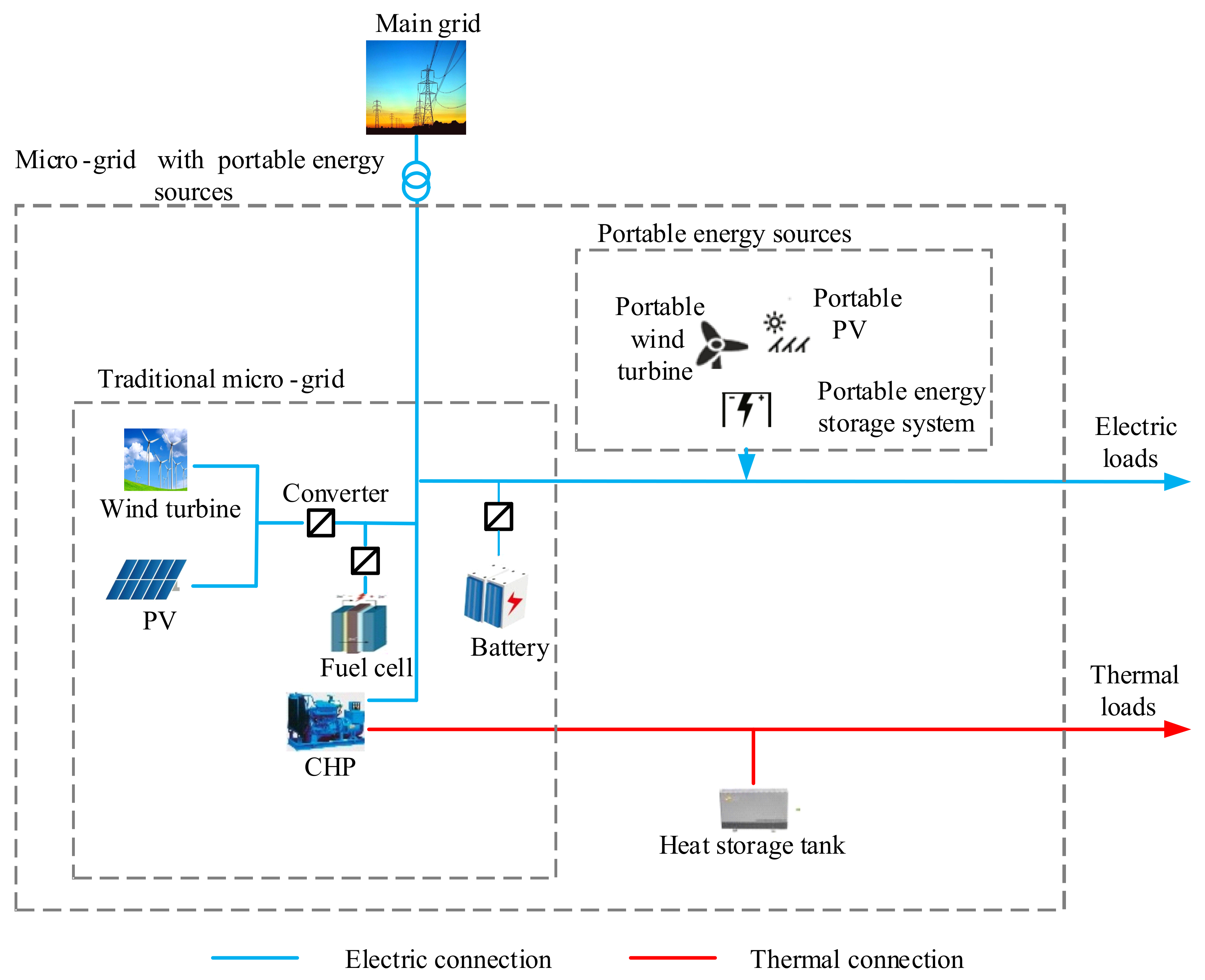
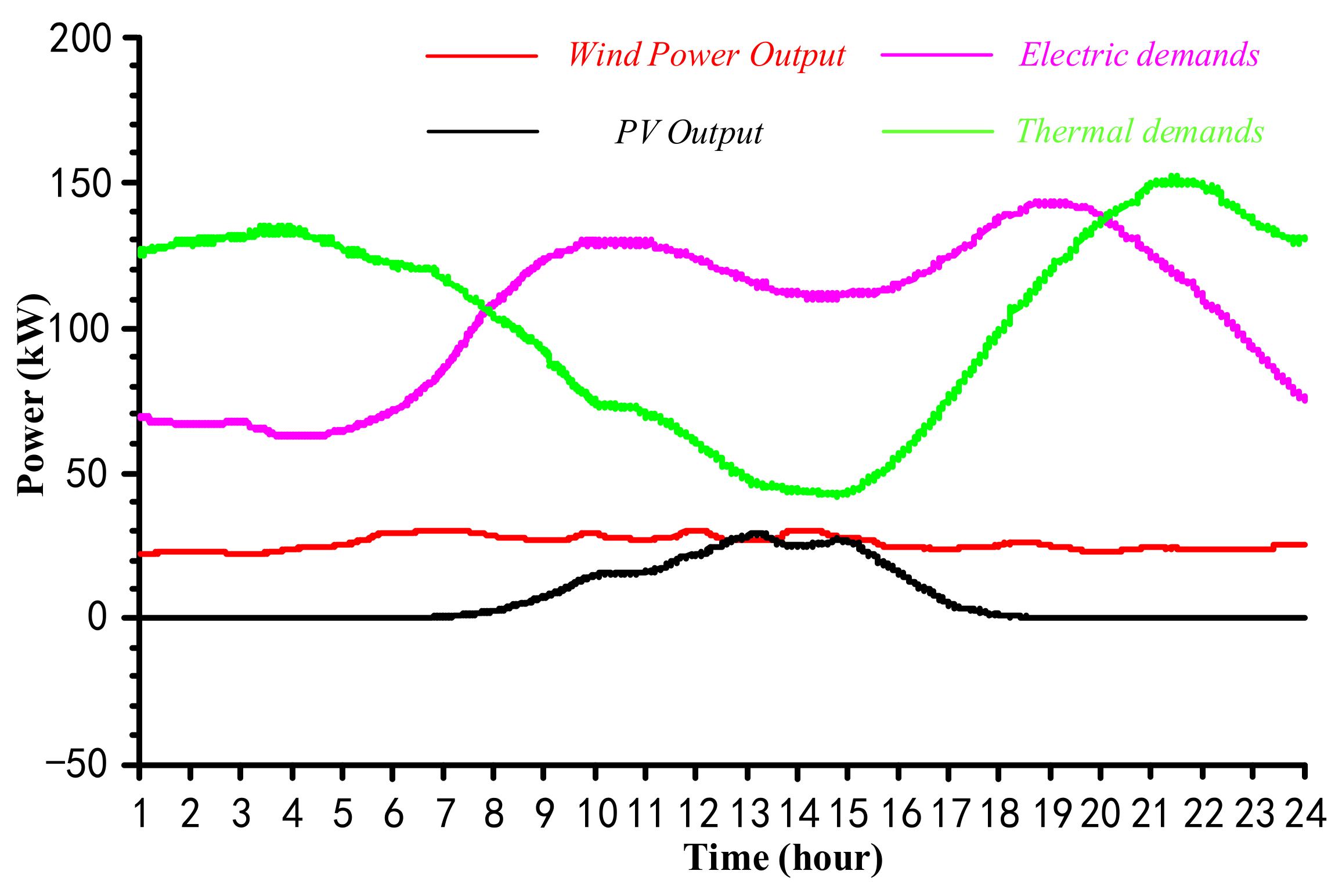
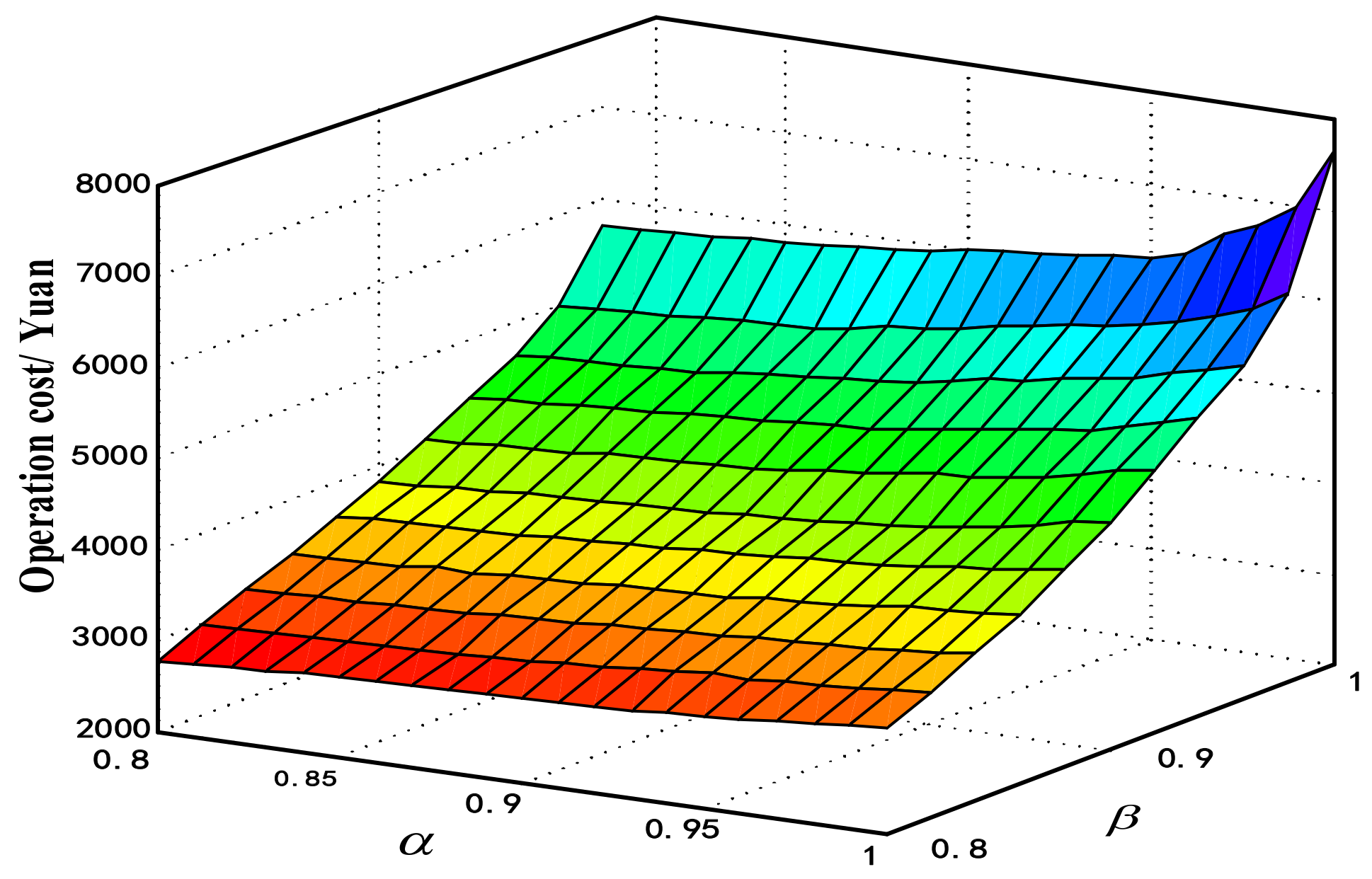
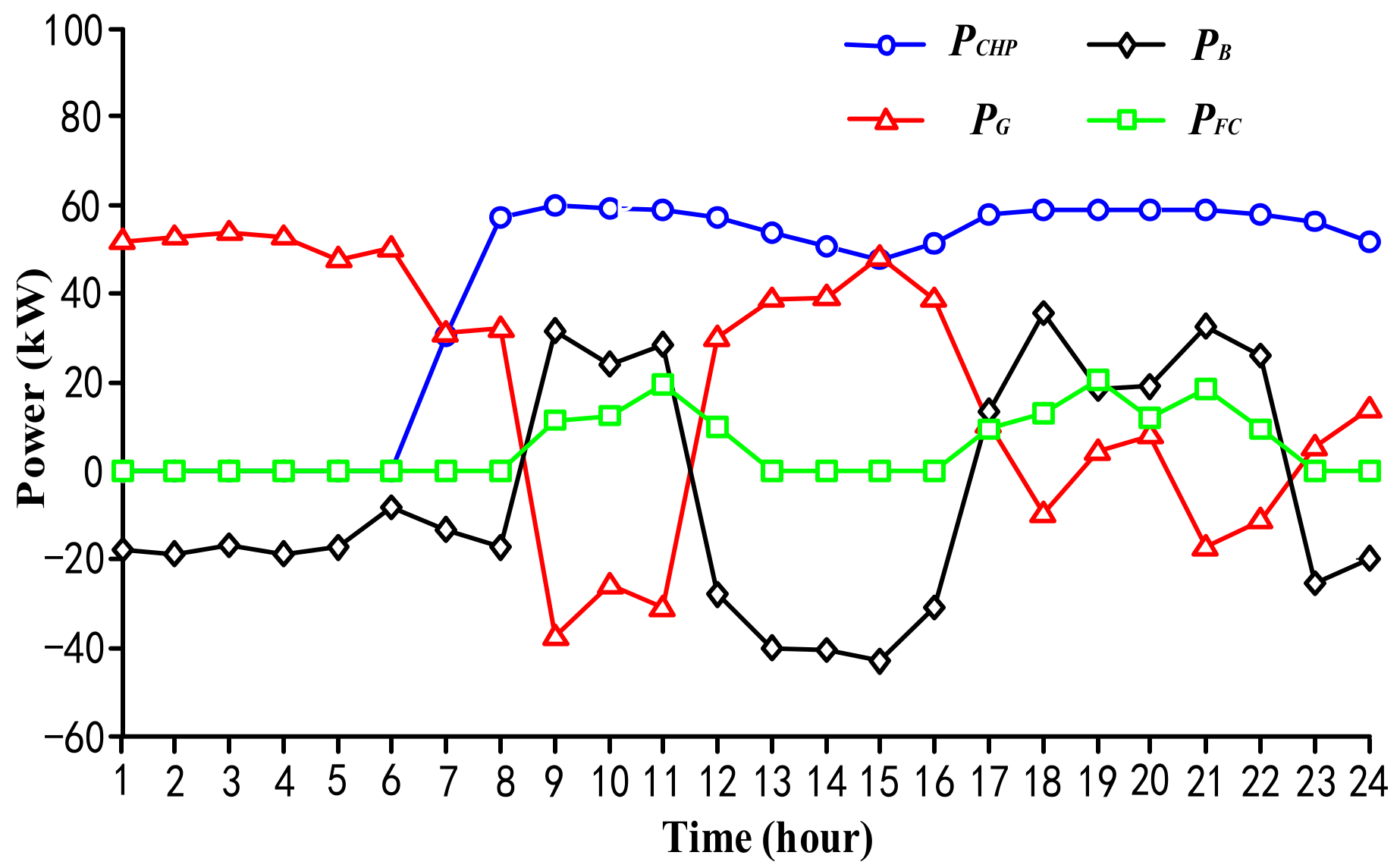

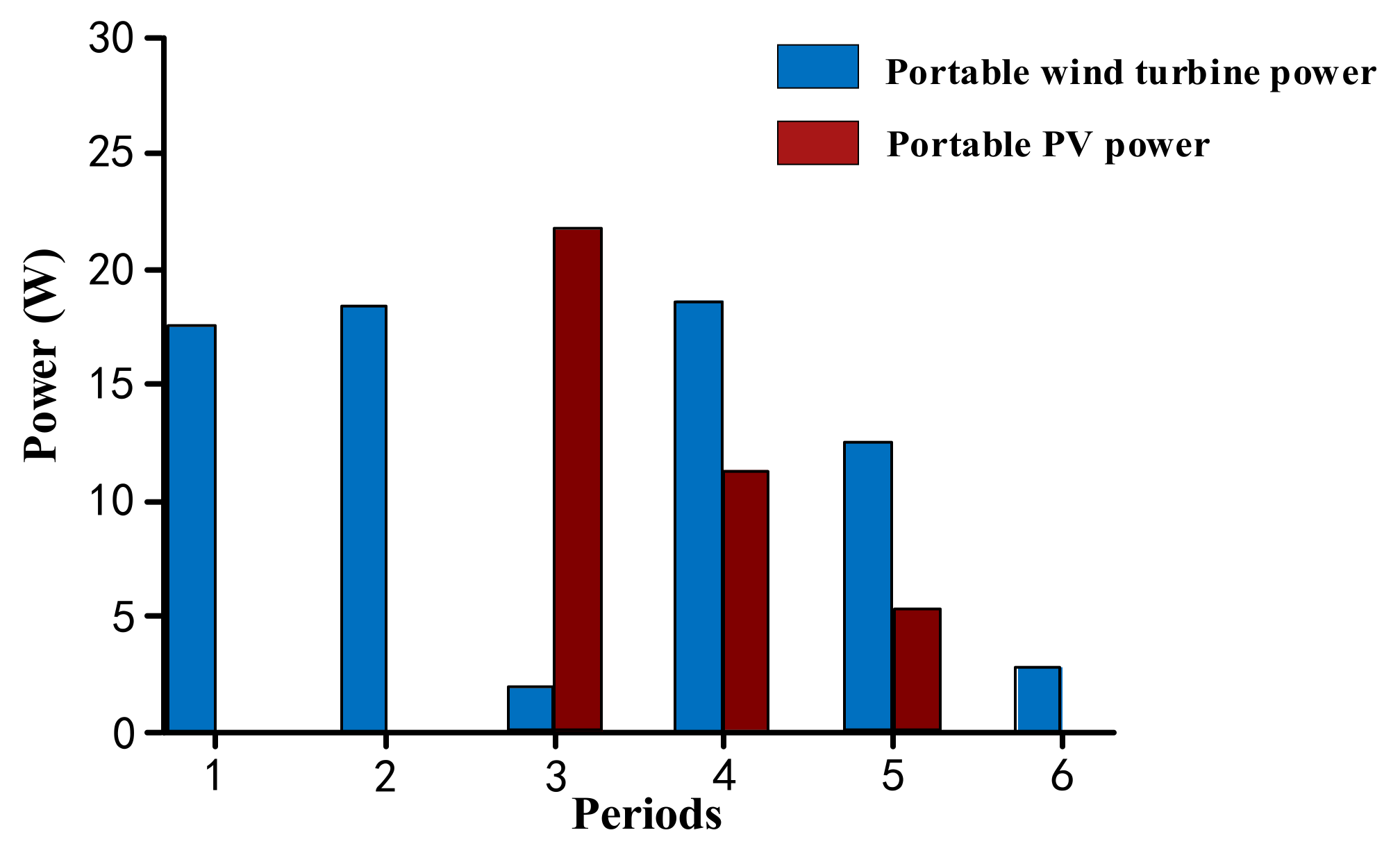
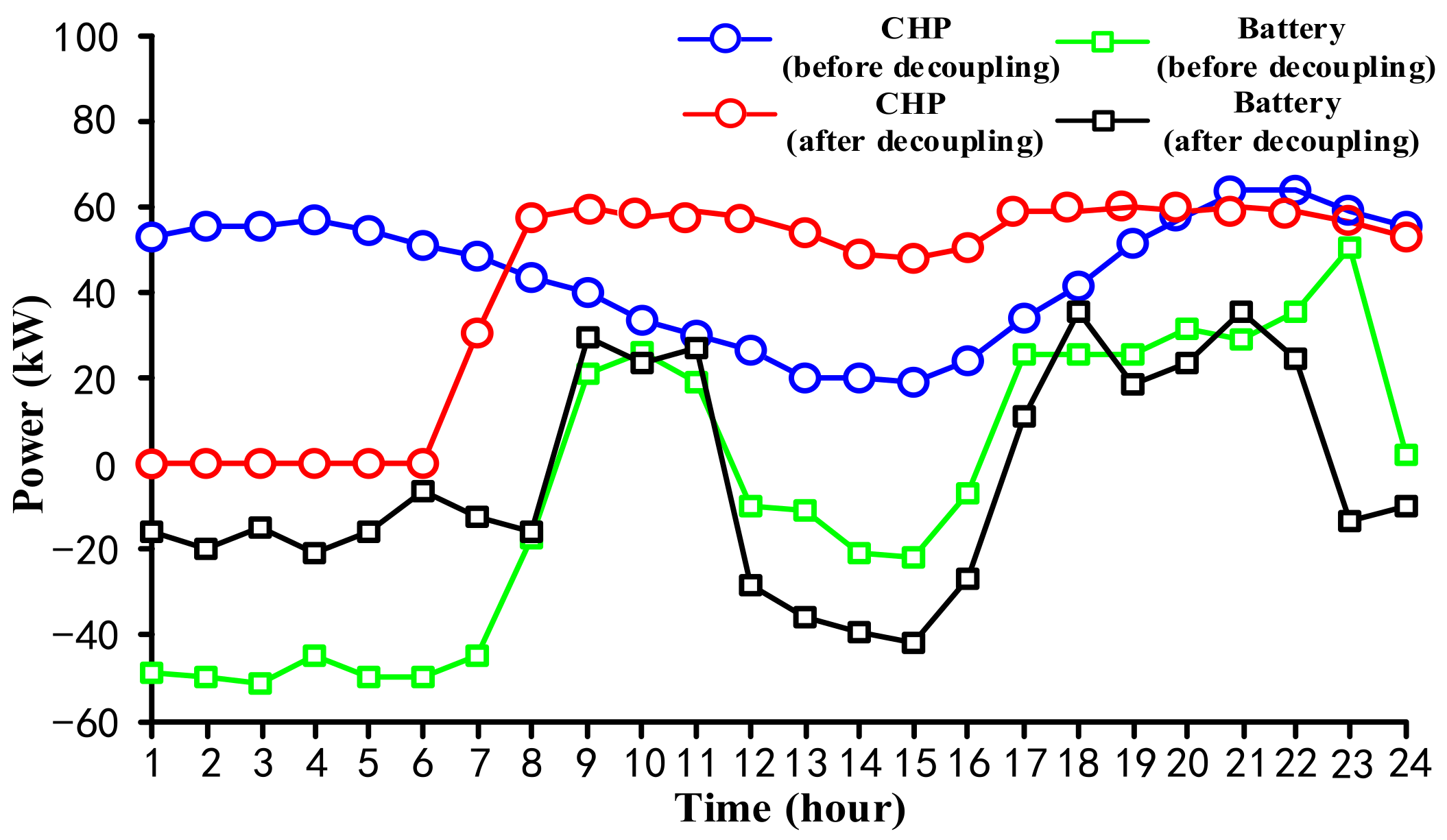
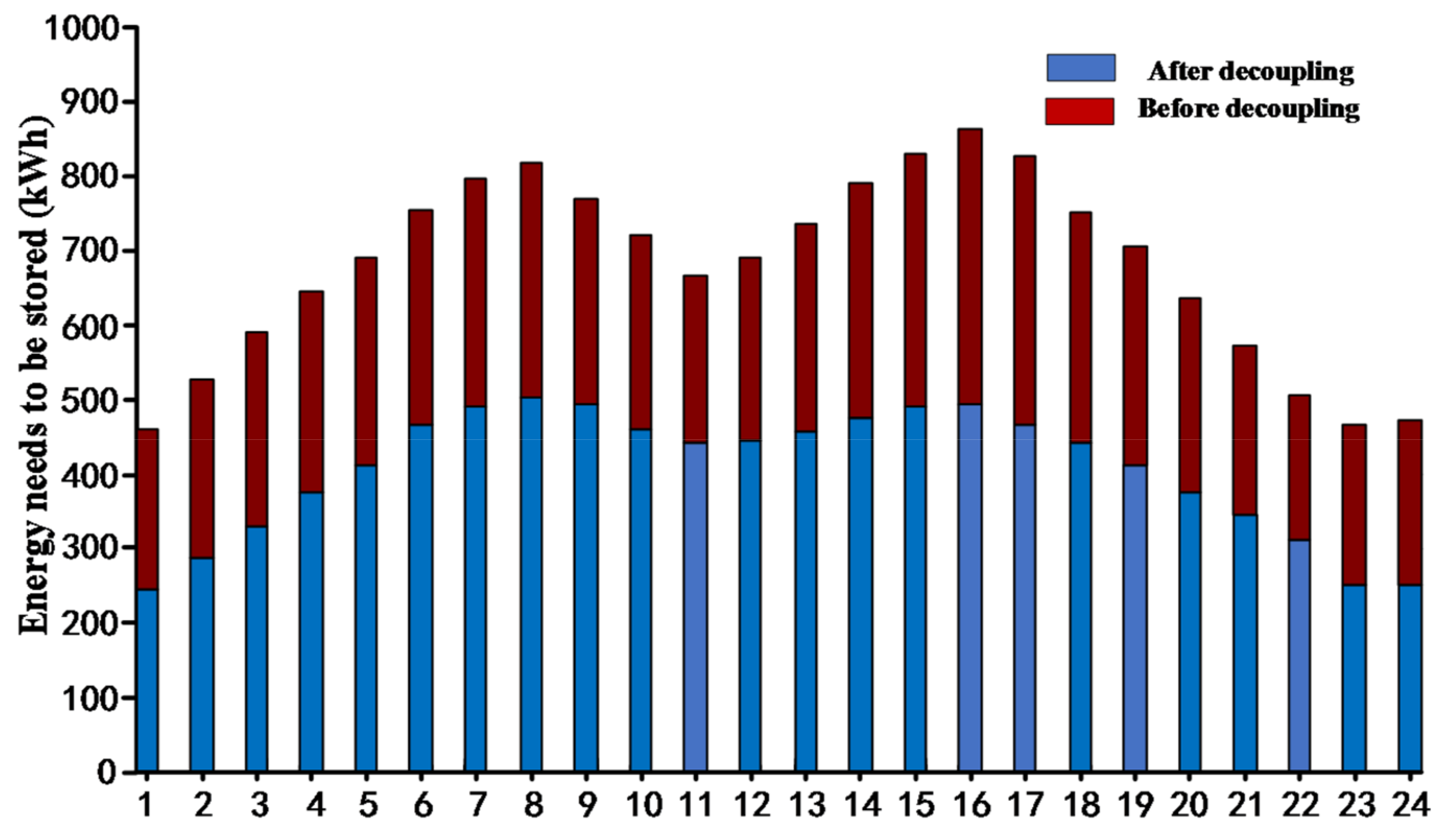
| Energy Carrier | CHP | Wind Turbine | PV | Fuel Cell | Battery System |
|---|---|---|---|---|---|
| Capital cost (10,000 Ұ/kW) | 1.0 | 1.2 | 2.0 | 2.8 | 0.0667 |
| Life (Year) | 10 | 10 | 20 | 10 | 10 |
| Min power (kW) | 15 | 0 | 0 | 7 | −60 |
| Max power (kW) | 75 | 30 | 30 | 40 | 60 |
| Parameters | Rated Value | Parameters | Rated Value |
|---|---|---|---|
| ρ (kg/m3) | 0.8 | Tamp (°C) | 20 |
| A (m2) | 10 | GTSTC (kW/m2) | 1 |
| ηw | 0.59 | TNOC (°C) | 45.5 |
| vnom (m/s) | 12 | PPV,STC (kW) | 0.165 |
| vi′ (m/s) | 5 | γ | 0.043% |
| vo′ (m/s) | 22 | Tr (°C) | 25 |
| β | Operational Costs (Ұ) | ||
|---|---|---|---|
| α = 0.8 | α = 0.9 | α = 1.0 | |
| 0.8 | 2776.47 | 2926.02 | 3152.34 |
| 0.9 | 3866.33 | 4016.04 | 4502.28 |
| 1.0 | 5747.36 | 6038.09 | 7605.58 |
| Periods | PCHP (kW) | PFC (kW) | PWT (kW) | PPV (kW) | PB (kW) | PSell (kW) | PBuy (kW) |
|---|---|---|---|---|---|---|---|
| 1 | 0 | 0 | 22.43 | 0 | −18.18 | 0 | 52.97 |
| 2 | 25.12 | 0 | 27.48 | 2.50 | −13.98 | 0 | 42.75 |
| 3 | 72.90 | 13.33 | 28.58 | 14.98 | 15.20 | 16.20 | 0 |
| 4 | 52.03 | 0 | 25.35 | 24.25 | −31.03 | 0 | 41.50 |
| 5 | 67.82 | 13.74 | 24.28 | 1.62 | 21.55 | 0 | 2.98 |
| 6 | 55.60 | 7.21 | 25.48 | 0 | 2.61 | 0 | 1.88 |
| Total cost (Ұ): 1919.98 | |||||||
| Periods | PCHP (kW) | PFC (kW) | PWT (kW) | PPV (kW) | PB (kW) | PSell (kW) | PBuy (kW) |
|---|---|---|---|---|---|---|---|
| 1 | 0 | 0 | 22.43 | 0 | −18.18 | 0 | 52.97 |
| 2 | 24.05 | 0 | 27.48 | 2.50 | −12.98 | 0 | 42.75 |
| 3 | 58.95 | 11.29 | 28.58 | 14.98 | 14.03 | 21.2 | 0 |
| 4 | 53.98 | 0 | 25.35 | 24.25 | −32.63 | 0 | 41.50 |
| 5 | 58.65 | 12.60 | 24.28 | 1.62 | 21.55 | 1.2 | 0 |
| 6 | 56.30 | 7.01 | 25.48 | 0 | 3.23 | 0 | 1.88 |
| Total cost (Ұ): 1376.71 | |||||||
© 2018 by the authors. Licensee MDPI, Basel, Switzerland. This article is an open access article distributed under the terms and conditions of the Creative Commons Attribution (CC BY) license (http://creativecommons.org/licenses/by/4.0/).
Share and Cite
Zhang, H.; Zhang, Q.; Gong, T.; Sun, H.; Su, X. Peak Load Regulation and Cost Optimization for Microgrids by Installing a Heat Storage Tank and a Portable Energy System. Appl. Sci. 2018, 8, 567. https://doi.org/10.3390/app8040567
Zhang H, Zhang Q, Gong T, Sun H, Su X. Peak Load Regulation and Cost Optimization for Microgrids by Installing a Heat Storage Tank and a Portable Energy System. Applied Sciences. 2018; 8(4):567. https://doi.org/10.3390/app8040567
Chicago/Turabian StyleZhang, Hong, Qian Zhang, Taorong Gong, Hao Sun, and Xin Su. 2018. "Peak Load Regulation and Cost Optimization for Microgrids by Installing a Heat Storage Tank and a Portable Energy System" Applied Sciences 8, no. 4: 567. https://doi.org/10.3390/app8040567




